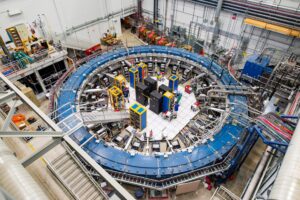In the media, several Nikhef physicists reacted enthusiastically about the new measurements of the magnetic dipole moment of the muon at Fermilab, which were presented Wednesday.
The measurements indicate with a reliability of 4.2 sigma that the muon receives from the vacuum more nudges than theory predicts. This could indicate undiscovered particles.
The deviation is already statistically relevant, but according to the house rules of particle physics, not yet a discovery. That is only the case with deviations of 5 sigma or more between measurements and theory. The chance that the deviation is a coincidence is then smaller than 1 in 3,5 million.

Researchers are so excited in part because the experiment has not yet processed all of the measurement data. With more data, the results would become even more reliable and could possibly even pass the 5 sigma mark, is the hope.
In the Volkskrant, Nikhef researcher Tristan Du Pree told how he followed the briefing from the US at home on Wednesday with pizza and beer and “danced in my living room” at the unexpectedly solid result. “This is what we have been waiting for for twenty years.”
NRC Handelsblad noted excited reactions from Freya Blekman, a Dutch particle physicist affiliated with the Free University of Brussels, and from Nikhef researcher and university lecturer in Groningen, Gerco Onderwater.
Onderwater was involved with his Groningen colleague Klaus Jungmann for a time in the g-2 measurements when they were still taking place at Brookhaven. He talked about the new research result on Thursday afternoon at BNR Nieuwsradio. Earlier theorist Elisabetta Pallante from the University of Groningen was part of the team doing the calculations of g that could be compared with measurements.
Nikhef’s Rasa Muller and science journalist Anna Gimbrère discussed the news on Thursday in the TV-programme de Vooravond.
The deviation found relates to the magnetic dipole moment g of the muon, the heavier brother of the electron. In a perfect vacuum, that value for the particle’s spin motion would be exactly 2. According to particle theory, the vacuum is teeming with short-lived particles and antiparticles, which can slightly influence the spinning muon.
The value found for g deviates a fraction from the best calculations, it seems. This possibly gives direction to an extension of the Standard Model of particle physics. This could be a signal for a yet unknown particle, for example a second type of higgs.
Two weeks ago, the LHCb experiment at CERN presented measurements that also point toward a deviation from the Standard Model, there in an unexpected difference between electrons and muons. A new particle could be involved in this too.